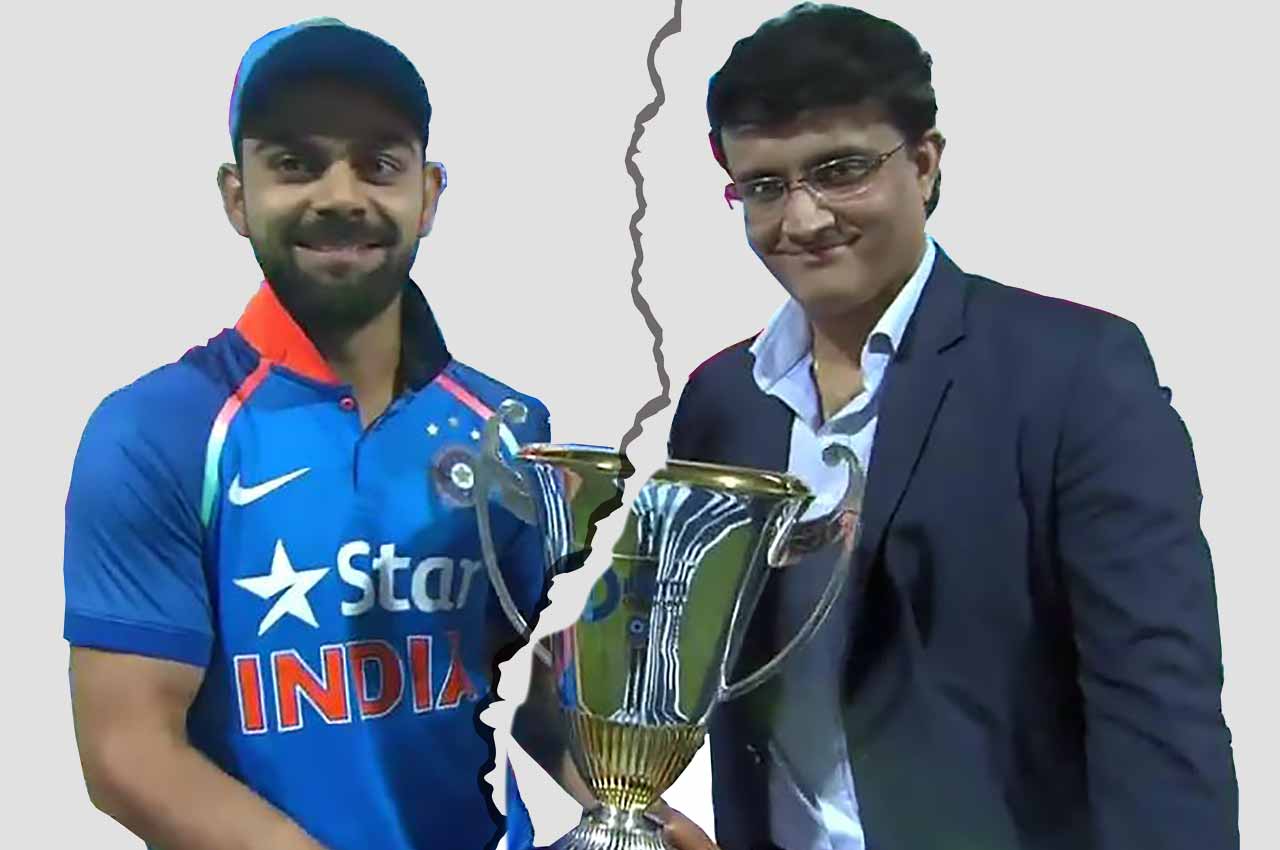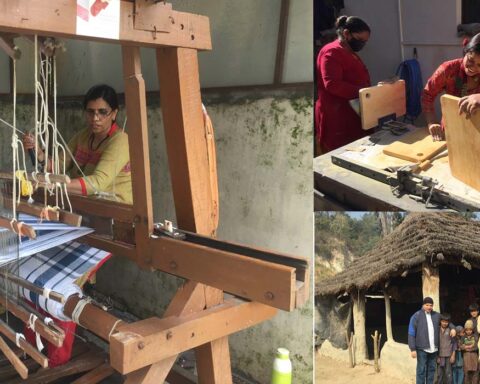For quite a few years now, the national cricket team was among the few reasons for Indians to smile, and successive captains worked in sync with the Board of Control for Cricket in India (BCCI). It was almost as if we had forgotten that they could be at loggerheads on issues and egos, as the past has shown. And while discord between the team leadership and cricket officialdom has been brewing for a while, everyone thought – or at least hoped – that the two sides would smoke the peace pipe, as it were.
Yet, not many would have been surprised when the Sourav Ganguly-Virat Kohli saga broiled over into full public glare in early December. The nature of the dispute, which consumed fans and connoisseurs alike, was a shock. It was hard for logical minds to reconcile with the manner in which Kohli was sacked as skipper of the Indian team for One-Day Internationals (ODIs), especially with a major Test tour just over the horizon.
Let it be said very early: Beyond the palest shadow of doubt, it is the mandate and prerogative of the BCCI’s selection committee to appoint or sack captains. It is up to the committee to decide when it will inform a cricketer that he has been made captain or has been removed from that position.
Familiar tale of power calling the shots
Few Indian cricket captains have dared to take on those in the corridors of power within the Board of Control for Cricket in India (BCCI). Fewer still have survived the battle. There have been many instances of skippers falling out with cricket officials of the time but Virat Kohli becomes the first to square up against the BCCI in the full glare of social media.
Lala Amarnath, independent India’s first Test captain, had a massive run-in with the then Board president, Anthony de Mello, who charged the Indian captain with, among other things, accepting a bribe to include Probir Sen in the Test XI. In a long-drawn battle, Amarnath had the last laugh by getting de Mello ousted from his post in 1950 and keeping him out two years later.
Bishan Singh Bedi was up in arms against the cricket establishment, having been banned for a Test in 1975 after he appeared in a TV interview and asked hosts in Nagpur to ensure good facilities – read hot water in the room – for the entire team rather than just the captain and manager. He kept the job as Board officials were unsure how to deal with the situation.
A decade later, Kapil Dev was skipper in the 1987 Reliance Cup, his second World Cup in succession as leader, when several members of the Indian team wore a sponsor’s logo on their shirts against the diktats of the Board. He paid the price by being sacked as captain after India lost the semi-final to England.
Dilip Vengsarkar, one of India’s most elegant batsmen who replaced Kapil Dev as the captain of the side, wrote syndicated columns in newspapers against BCCI directives and ended up conceding his leadership to Krishnamachari Srikkanth for the tour of Pakistan in 1989.
Though Mohammed Azharuddin and Sachin Tendulkar played musical chairs for a while, their tenure was largely without any major dispute with Board officials. And when Sourav Ganguly took over as captain and enjoyed the backing of Board mandarin Jagmohan Dalmiya, it seemed that the captain-Board fissures were a thing of the past.
Until the genial Rahul Dravid quit captaincy in 2007. It was said he wanted to focus on his batting but it was also true that he was not enjoying the captain’s role anymore, leaving us to draw our own conclusions about what caused him to exit. And one of the popular perceptions back then was that he did not fancy the pressure from ‘external sources’ aka the Board.
With Board presidents backing the likes of Ganguly and Mahendra Singh Dhoni, it looked as if peace prevailed in the space between cricket officials and captains. But with Facebook, Twitter and Instagram becoming part of our lives, it was only a matter of time before the old sagas were recycled for a new generation of fans to witness.
The decision to announce the change in ODI captains when only the Test team was selected and the lack of grace of the powers that be in acknowledging the incumbent’s role in the Indian ODI team securing a 70 percent success rate under his leadership made people sit up and take note. It did not need much for everyone concerned to sense that something was seriously amiss.
Some 24 hours later, Ganguly sought to douse the fire with a vanilla statement to a few mediapersons. The impression conveyed by the Board president – himself a former India captain of some distinction – was that an attempt had been made to dissuade Kohli from quitting as captain of the T20 team and that the Board then chose to divest him of the ODI captaincy as well.
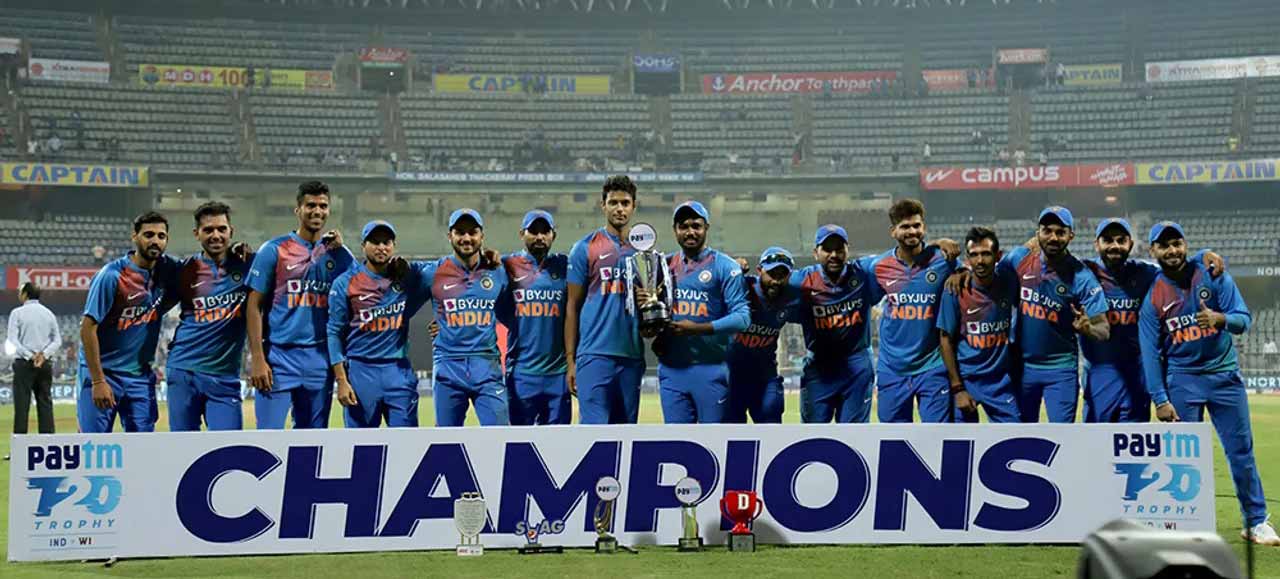
Out in the open
Kohli’s press conference that came on the eve of the Test team’s departure for South Africa – India’s final, unconquered frontier, so to say – only confirmed the suspicion that all was not well between the captain and, in a manner of speaking, his employers. Kohli walked the tightrope without identifying anyone by name or even designation. He avoided personal attacks, stating that the information in the public domain was ‘inaccurate’.
“Whatever was said about the communication that happened about the decision that was made was inaccurate. When I left the T20 captaincy, I first approached BCCI and intimated it of my decision. I gave the reasons and my viewpoint was received very nicely. There was no offence, no hesitation and not once was I told that ‘You should not leave T20 captaincy’,” he said.
Based on what they chose to believe, fans of Kohli and Ganguly and the larger social media universe engaged in a bitter war of words, trolling one another with no punches pulled and wild theories aired. None seemed to have the time and the inclination to understand the events and everyone was in a hurry to judge and diss one or the other central character in the unseemly drama before an important Test series.
Many former India captains and cricketers also joined in the debate without apparently arming themselves with the facts of the case. Some chose to believe that Kohli was being petulant about the ODI captaincy being taken away from him. Others embraced the idea of Ganguly needlessly trying to snub the Indian skipper.
It is indisputable that one’s perceptions are built by the information available at their disposal and personal experience, first-hand or acquired. With the line dividing the Board and its captain so strongly defined and with everyone finding a need to back one or the other central character, India’s cricket firmament is not exactly bound together, except by love for the game.
The rumour mills are busy churning out and airing a number of theories, though. Topics range from Kohli’s autocratic behaviour to the absence of ICC trophies in the past few years, from an IPL franchise pressing for a change of guard to the incumbent’s backing Mohammed Shami when the fast bowler was trolled after India’s loss to Pakistan in the ICC World Twenty20 in the UAE.
There are some other factors that have been held against Kohli’s leadership style. His perceived role in the ouster of Anil Kumble as coach of the Indian team in 2017 has sprung up yet again. The decision to fly home from Australia after one Test last year to be with his wife during childbirth has also surfaced. In that Test match, India collapsed to their lowest-ever total – 36 for the loss of nine wickets – against Australia at the Adelaide Oval.
The decision to announce the change in ODI captains when only the Test team was selected and the lack of grace of the powers that be in acknowledging the incumbent’s role in the Indian ODI team securing a 70 percent success rate under his leadership made people sit up and take note.
The touring team lost that match by eight wickets but scripted a turnaround for the ages with the final match at Brisbane handing India a series win. Kohli again came in for a hiding on social media, but received plenty of support too.
On the field, Kohli’s perceived ‘lack of agility’ in decision-making in white-ball cricket – more likely in the ICC events – has been cited as a factor for his abrupt removal. The buzz about his handling of off-spinner R. Ashwin and left-arm wrist spinner Kuldeep Yadav has also resurfaced, this time with decibels added to make it sound more credible.
Ganguly is on record as saying that the Board did not want different leaders for the white-ball formats but we have not heard from the selectors that that is what they also thought when overlooking Kohli’s record of 70 percent wins in ODIs. Yet, we do not know the reasons for the selectors’ decision to take the ODI captaincy away from Kohli and give it to Rohit Sharma.
Harmony the key
Come to think of it, it may not always be possible for Board mandarins and the national team to be in sync but all of them must work towards greater harmony. As in any relationship, differences of opinion are bound to crop up from time to time in the country’s cricket landscape. Yet, they need to be addressed with dignity, grace and urgency and not allowed to simmer. It should be the easiest of things for all parties to communicate clearly, perhaps by issuing joint statements each time critical decisions are made. It would leave no one in any doubt that everyone is pulling the cart in the same direction, leaving power struggles in the backseat. It would portray a better image of cricket at the top.
There are some who suggest that since this could have been a deliberate bid to snub Kohli, it does not warrant expecting dignity and grace. Their argument is bolstered by the fact that the ODI team was not announced even a fortnight after the BCCI indicated the change of ODI leadership when naming the Test squad chosen for the tour of South Africa. The uncharitable even suggest that Ganguly had waited long to get even with Kohli. They believe that the board president had not only not forgotten but was also unforgiving about the Indian captain’s possible role – with help from the then Committee of Administrators – in over-riding a 2017 decision of a panel to back Kumble as coach.
As Board president, Ganguly may have spent more time overseeing cricketing aspects like getting Rahul Dravid as coach to replace Ravi Shastri and V.V.S. Laxman to take over the reins of the National Cricket Academy than in running the Board itself. He may have revealed his hands-on role by speaking about selectorial decisions, typically the domain of selectors rather than Board presidents.
The last time a Board president was so visibly active on the cricket front was when Sharad Pawar had to mediate an ungainly dispute between an erstwhile captain and coach. Ganguly’s spat with Greg Chappell in 2007 was so high-profile and in the public domain that it needed Pawar to step in and broker an uneasy truce. Barring such necessities, Board presidents have always let the Chairman of Selectors face the media.
There can be no doubt that this unsavoury episode does not convey the best messages to youngsters in the game. All the wealth, not just the experience, at the beck and call of the Board seemed to be of little use in preventing a communication failure from playing out as a huge controversy. How this plays out in the long term remains to be seen, but there is little doubt that the Ganguly-Kohli episode left many lovers of the game – players and fans alike – with a bad taste in the mouth.
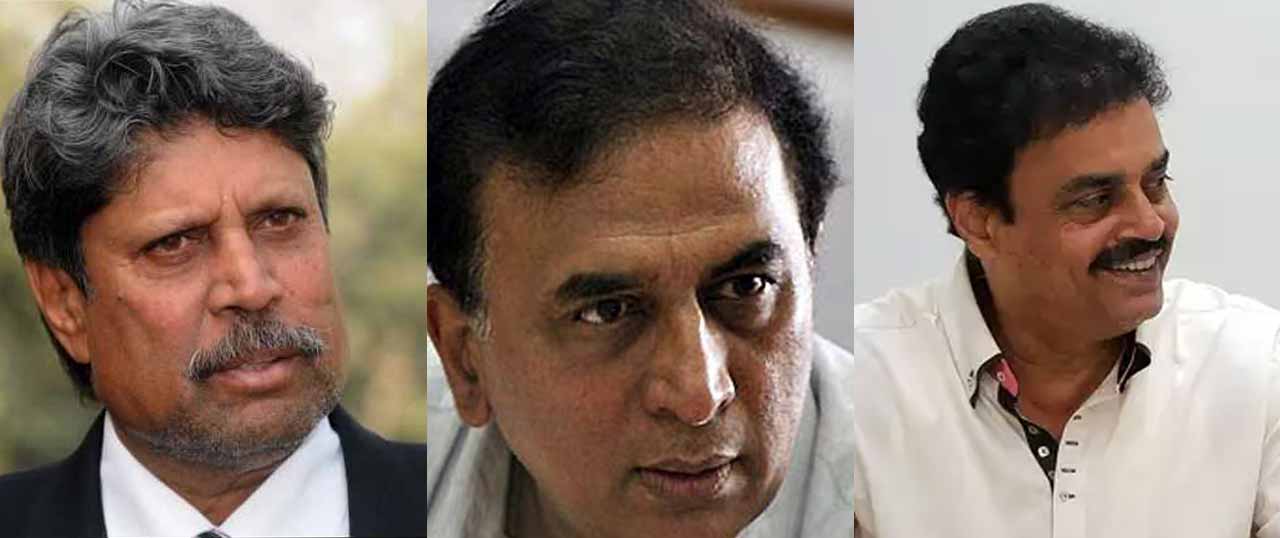
The Virat Kohli episode : What they said
Sunil Gavaskar (former India captain)
“We may see the Virat from two years ago, slamming centuries after centuries.”
– on Sports Talk.
Kapil Dev (1983 World Cup-winning captain)
“I am a big fan of Virat Kohli but I don’t think any player should speak against (the) BCCI president or the Board. When I was taken out as skipper I was also hurt but remember you are playing for your country. Nothing matters more.”
– on ABP News.
Dilip Vengsarkar (former India captain)
“It has always been the case right from 1932 (when the first Indian team was selected). Once we saw four captains in five Test matches. But yes, things should change now. Kohli, you have to respect him, he has done so much for the country, so much for Indian cricket. But how they dealt with him, it must have definitely hurt him.
The thing is that Ganguly had no business to speak on behalf of the selection committee. Ganguly is president of the BCCI. Any issue about selection or captaincy, it’s the chairman of the selection committee who should speak. Ganguly spoke about the whole thing, obviously Virat wanted to make his case clear. I believe it should have been between the chairman of the selection committee and the captain. A captain is selected or removed by the selection committee, that’s not Ganguly’s jurisdiction at all.
It seems that India – especially the BCCI – has not learnt from history and Ganguly from personal experience when he was displaced as captain. Back in 2005, there was a massive public outcry when he was given the cold shoulder by the selectors. It would have been fair to expect some statesmanship, perhaps even studied silence, from the Board president in keeping with the office. Sadly, the perceptible absence of empathy in the latest episode shakes, if not entirely dismantles, the belief that former athletes will bring that quality to the table in abundance when they take on the mantle of administrator after retirement from competitive sport. It can only be hoped that this clash is a one-off and dies a quiet death.
The first month of the new year will likely reveal if Kohli’s desire to lead a cricket team on the field has been affected by the goings-on and whether he is capable of adapting to changed circumstances at a time when he has possibly retained or, in some cases, lost the respect of the others as a batsman and as a leader.
One thing is certain, though. Kohli has always had the courage to stand apart. He has been defiant, dissenting and, some would say, even divisive. Will his act of ‘insubordination’ a
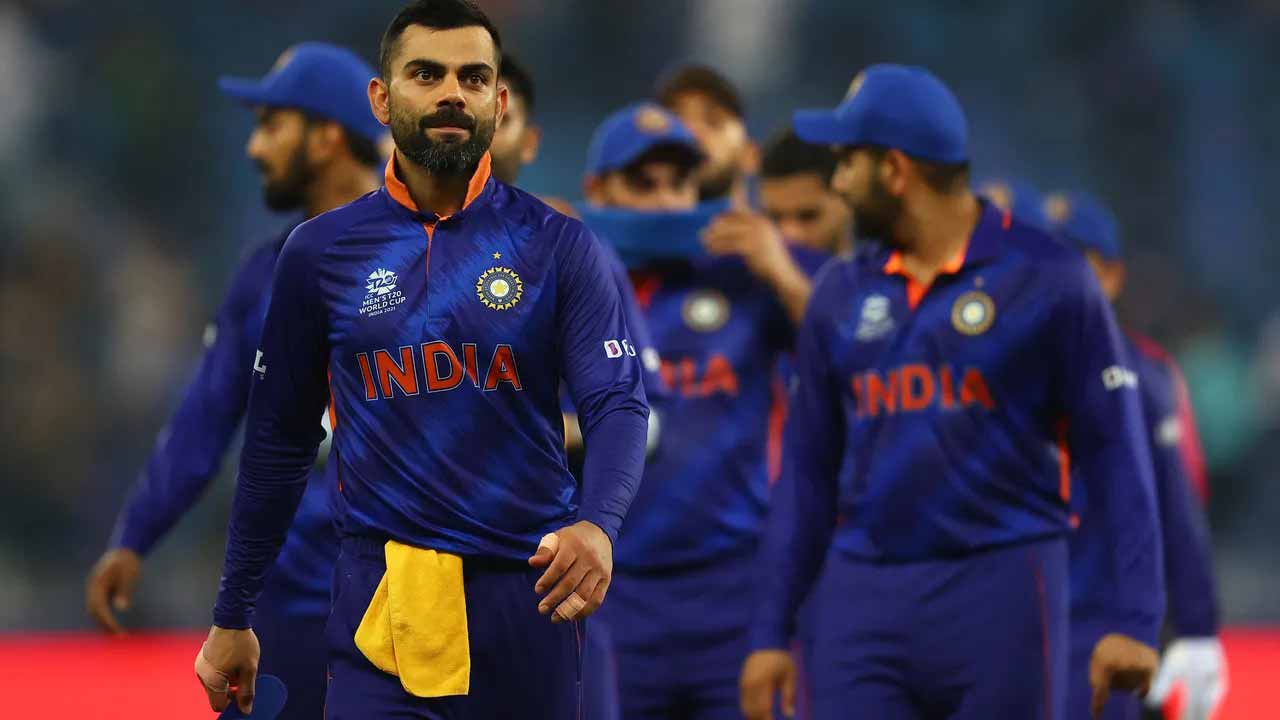
gainst the BCCI lead to the national team getting better? Or will the squad be distracted by the captain’s run-in with officialdom?
The Indian team’s journey, both in Tests and limited-overs cricket, will be interesting to track in the immediate aftermath of this controversy. At the moment, there is also no knowing what the Board will do. “We shall deal with it. Leave it to the Board,” Ganguly has said. Some found an ominous ring to the statement. We must wait to see what this entails. For, second-guessing the Board is neither advisable nor smart.
Similarly, it would be foolhardy to imagine Kohli pre-empting any action by quitting the Test captaincy as well sooner rather than later. The one thing none can accuse him of is lacking the courage of conviction in his role as captain. He has been steadfast in his beliefs and while he has mellowed a bit, he has never fought shy of sticking to his position.
Kohli walked the tightrope without identifying anyone by name or even designation. He avoided personal attacks, stating that the information in the public domain was ‘inaccurate’.
Dravid will have to bring cohesion in his early days as chief coach in much the same manner he did when he took over captaincy from Ganguly who had a massive fall-out with the then coach, Australian batting legend Greg Chappell. Dravid’s man management skills will be called upon quickly to get the squad to focus on discovering its instinct for competition in all conditions. By all accounts he made a good start in rebuilding and repairing in Johannesburg.
While the cricketers and their coaching staff do their jobs in South Africa, it may help if fans and TV anchors stay away from the controversy and focus on the cricket that will unfold in the Test series. And, it will help if Board officials who prefer not to be named when sharing information freely refrain from adding fuel to the fiery debate. What is certain is that there is more to come, if the past is any indication.

